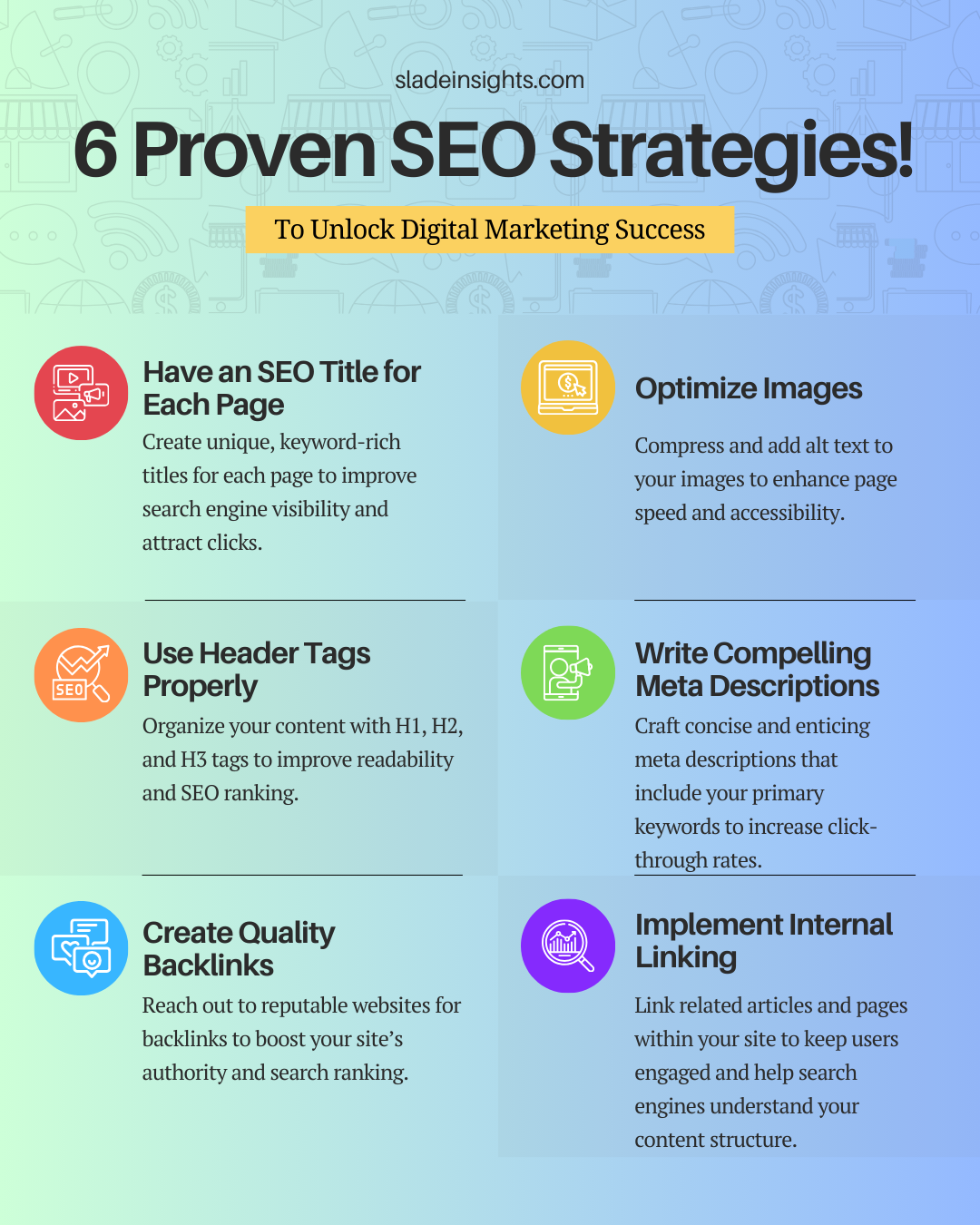Top 5 Beginner Steps to improve your websites SEO
Improving your website’s SEO can seem like a daunting task, especially if you’re just starting out. However, by focusing on a few fundamental strategies, you can make significant strides in boosting your site’s visibility and ranking on search engines. These five SEO tips and best practices are all examples of basic steps you can take to improve your website. You’re making changes that will help potential customers and search engines better understand your business.
Key Takeaways
- Conduct thorough keyword research to identify the terms your target audience is searching for.
- Create high-quality, relevant content that provides value to your visitors.
- Optimize on-page elements such as titles, meta descriptions, and headers to improve search engine understanding.
- Implement off-page SEO strategies like backlink building to enhance your site’s authority.
- Ensure your website is mobile-friendly to cater to the growing number of mobile users.
1. Keyword Research
Keyword research is the foundation of any successful SEO strategy. It’s as simple as picking a list of words and phrases relevant to your business. Think about which words are most likely to get people to do what you want them to do (visit your website and submit a form) and focus on those words.
Find Keywords
Keywords are words or phrases that searchers use to find content on search engines. For example, someone might type in the keyword phrase “Ice cream near me” if they want to find a local ice cream shop. A keyword is essentially what people will type in when searching for something. This is why you should make sure your keyword aligns with the search intent of your target audience. It can be a short keyword like ‘digital marketing’ or a long-tail keyword such as ‘how to create a good digital advertising campaign’.
Conduct Keyword Research
I’ve found that a dedicated keyword research tool can be extremely helpful, but as a beginner, you can also intuitively choose your keywords first. For instance, if you sell roasted coffee, you might opt for “roasted coffee,” “Colombian coffee,” and “local coffee roaster.”
Doing keyword research right helps you understand what your target audience is searching for, tailor your content to your audience, and drive more traffic to your site.
2. Quality Content Creation
Creating quality content is the backbone of SEO for new websites. When you create new content on your website, like pages or blogs, you’re increasing your chances of showing up in search. This is why so many businesses invest in content marketing: The goal is to create content that attracts organic traffic through clever keyword targeting.
Start with Extensive Research
To create high-quality content, you should have a deep understanding of the topic. For that, you must research thoroughly. This will help you cover your topic in full and not leave out important information.
Write Unique and Up-to-Date Content
When you’re writing new content, don’t copy others’ content in part or in its entirety. Create the content yourself based on what you know about the topic. Also, check in on previously published content and update it as needed, or even delete it if it’s not relevant anymore.
Make it Easy-to-Read and Well Organized
Write content naturally and make sure it is well written, easy to follow, and free of spelling and grammatical mistakes. Break up long content into paragraphs and sections, and provide headings to help users navigate your pages.
Hyperlink Your Existing Content
If the post you are currently writing is related to another post you’ve already written, link it! It’s good practice to hyperlink your content to other posts and pages on your website. This will contribute to a better user experience by helping the reader further discover related content and navigate to other pages on your site, as well as helping bots in indexing and contextualizing your webpages.
Remember: Quality content is not just about writing; it’s about providing value to your readers and ensuring they have a great experience on your site.

3. On-Page SEO Optimization
On-page SEO is all about tweaking the back end of your website to make it more appealing to search engines. This step is crucial for gaining traction in the SERPs. Let’s dive into some key practices to optimize your on-page SEO.
Writing Unique, High-Quality Content
Creating content that matches search intent is essential. Make sure your content is unique and provides value to your audience.
Crafting Descriptive Title Tags
Your title tags should be brief and include your target keyword. This helps search engines understand what your page is about.
Writing Engaging Meta Descriptions
Meta descriptions should be engaging and include relevant keywords. This can improve your click-through rate.
Optimizing Images with Descriptive Alt Text
Use descriptive alt text for your images. This not only helps with SEO but also makes your site more accessible.
Revamping Your Site Structure
Ensure your URLs have a clear hierarchy and are as short and simple as possible. This makes it easier for search engines to crawl your site.
Encouraging Indexing
Submit an XML sitemap to encourage search engines to index your site. This can help improve your visibility in search results.
Pro Tip: Use tools like On Page SEO Checker to get tons of optimization ideas conveniently grouped by category.
4. Off-Page SEO Strategies
Off-page SEO is all about actions taken outside your website to improve your search engine rankings. Backlinks are the backbone of off-page SEO. The more websites that link to you, the more reputable your site appears to search engines. Here are some effective off-page SEO strategies:
Link Building
Link building is crucial. Focus on getting links from high-quality websites to build your site’s authority and credibility. You can achieve this through guest blogging, partnerships, and creating shareable content.
Social Media Engagement
Engage with your audience on social media platforms. Share your content, interact with followers, and participate in relevant discussions. This not only drives traffic but also increases your site’s visibility.
Local SEO
Off-page SEO is a continuous effort. Keep building relationships and creating valuable content to maintain and improve your rankings.
5. Mobile Optimization
Why Mobile Optimization Matters
As people increasingly use their mobile phones to access the internet, it’s a necessity to optimize your website for smart devices. If not, you’ll end up having a high bounce rate, because let’s be honest, no one wants to stay on a website that is not formatted right for your phone. Incorrect formatting could have annoying faults such as buttons that don’t work or having to scroll to the side just to see the page entirely.
Key Steps to Optimize for Mobile
- Responsive Design: Make sure your website theme uses responsive design. This ensures your site looks great on all devices, whether it’s a phone, tablet, or desktop.
- Optimize Title Tags and Meta Descriptions: These appear as blue, clickable text in search results and the copy that can appear below your title tags. Make sure they are optimized for mobile search character limits.
- Avoid Intrusive Pop-Ups: Pop-ups can be particularly annoying on mobile devices. Avoid them to ensure a smooth user experience.
Testing Mobile-Friendliness
To test your site’s mobile-friendliness, you can use Google’s Mobile-Friendly Test. This tool will show you how your site performs on mobile devices and provide recommendations for improvement.
A positive user experience makes people want to stay and explore your website, which again indicates that your page is relevant for the keyword you chose. In fact, mobile formatting is so important that Google announced it will soon be starting with mobile-first indexing of websites.
Having a mobile-optimized website is crucial for reaching your audience effectively. At Slade Insights, we specialize in creating responsive, user-friendly websites that not only look great on any device but also drive conversions. Ready to take your business to the next level?
Conclusion
These five SEO tips and best practices are all examples of basic steps you can take to improve your website. By implementing these strategies, you’re making changes that will help potential customers and search engines better understand your business. Remember, SEO is all about using the right words and serving relevant information to your audience. Avoid methods that don’t add value to your visitors, like keyword stuffing or invisible text. Stick to these beginner steps, and you’ll be on your way to boosting your website’s SEO in no time. Happy optimizing!
Frequently Asked Questions
What is SEO and why is it important?
SEO stands for Search Engine Optimization. It is important because it helps improve the visibility of your website on search engines, which can drive more traffic and potential customers to your site.
How do I start with keyword research?
Start by identifying the main topics relevant to your business. Use keyword research tools to find popular search terms related to those topics and analyze their search volume and competition.
What constitutes quality content for SEO?
Quality content is informative, engaging, and relevant to your audience. It should provide value, be well-written, and include relevant keywords naturally without keyword stuffing.
What are some on-page SEO optimization techniques?
On-page SEO techniques include optimizing title tags, meta descriptions, header tags, and URL structures. It also involves using internal links and ensuring your content is easily readable.
What is off-page SEO and why is it important?
Off-page SEO refers to actions taken outside of your website to improve its ranking, such as backlink building and social media marketing. It is important because it helps establish your website’s authority and credibility.
How can I optimize my website for mobile users?
Ensure your website is mobile-friendly by using responsive design. Optimize page load speed, make navigation easy, and ensure that all content is accessible on mobile devices.
